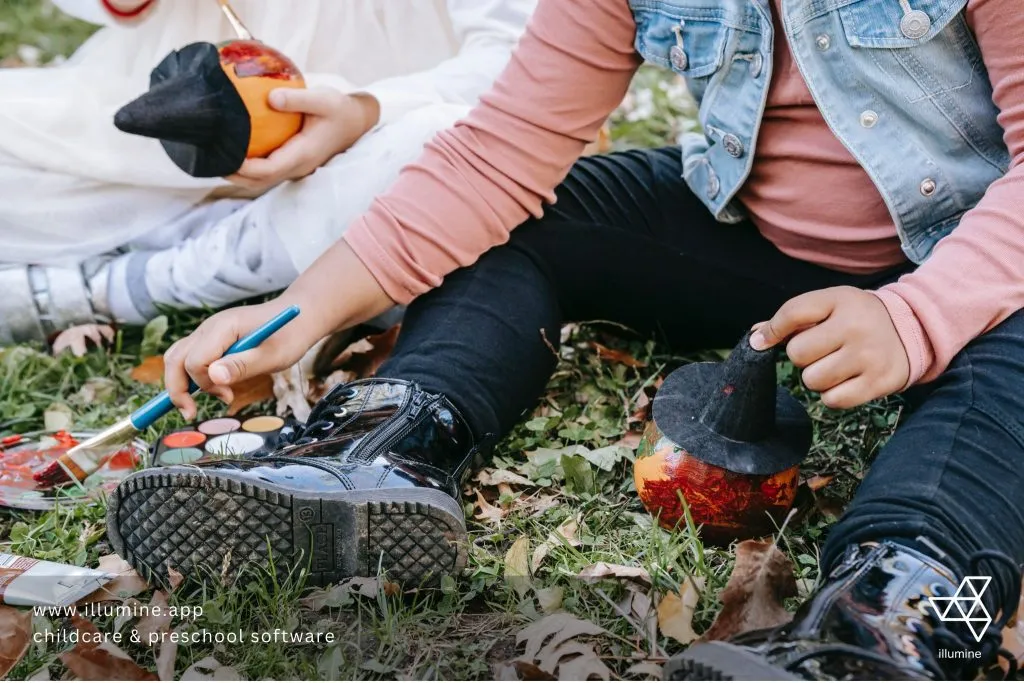How many times have you heard it’s important to mix preschool learning with fun? As a preschool teacher, probably a million times. But who says you can’t do both at once?
At this age, your students are thrilled about exploring. Which is why teaching them with preschool themes has tons of creative and cognitive advantages. Let’s unwrap the effectiveness of themes for preschool. You also get access to a year’s worth of preschool classroom themes your students will love!
What are preschool themes?
Also known as theme units, preschool themes are classroom activities that help teachers get tiny tots excited about learning lessons. They’re a framework to tie subjects like art, music, math, and reading with early childhood concepts in an engaging way.
These themes are typically centered around a topic like seasons, plants, or animals. Once the topic is locked, a preschool teacher plans learning materials around it. For example, when doing a post-winter holiday theme on snow, the teacher will integrate art projects, worksheets, stories, and music choices around it. The activities may include:
- Paintings featuring snow
- Singing songs about snow
- Discussions around how does snow form
- Reading books about snow
- Learning counting using snowflakes
It’s wise to involve kids in planning the themes as they should reflect the children’s environment, cultural makeup, and shared experiences. If a bunch of students in your class have family issues, picking a theme about different family structures and how they evolve over time would be a good idea.
Useful read: Bulletin Board Ideas
Why are themes important for preschoolers?
Recent research shows that themes assist tiny tots in creating patterns and making connections between concepts taught in school and real-life experiences.
Jane Healy, a child development expert, agrees, “I am increasingly convinced that patterns are the key to intelligence. Patterning information means really organizing and associating new information with previously developed mental hooks.”
Classroom preschool themes encourage pattern formations, expanding on the varied interests of children and encouraging them to see how learning is interconnected. Apart from that, designing the learning materials around a theme encourages:
- active exploration of the learning environment (sand, water, pebbles, and puzzles)
- natural curiosities of childhood
- play-based learning
- child-initiated activities
- different learning needs
- cross-curriculum connection
32 preschool classroom themes
Win over your preschooler’s hearts and minds with these fun, insightful and beloved preschool themes for your classroom.
Seasons

1. Winter
Acquaint your students with how people in different parts of the world prepare themselves for winter. For instance, Parisians drink hot chocolate with marshmallows. You can even host a marshmallow challenge to engage their imaginative and problem-solving skills.
2. Summer
Assign students an art project to tackle the common activities people indulge in and their dressing style during summer. You can also make a list of summer essentials for English.
3. Spring
Compare and contrast Spring with Fall by sharing photographic evidence. You can also ask children to sing a Spring-based song in class, accompanied by an instrument of their choice.
4.Fall
Take a look at why trees shed leaves during Fall in Science. Ask students to go on a leaf hunt and create leaf-rubbing art in class.
5. Monsoon
Make paper airplanes and boats to keep your students busy while it’s pouring outdoors. You can ask students to bring their favorite monsoon snack to class and list the food items that go into making them.
Precipitation

6.Rainbow
Explore the colours of the rainbow by teaching kids to make rainbow rice bins with colored rice or sing rainbow songs in the classroom. You can even encourage older preschoolers to write a poem on the subject.
7. Fog
For art class, show students how to make fog with white chalk on black construction paper. You can even take up a science project and try creating ‘fog in a bottle.’
8. Sun
Encourage students to show how the sun makes the water cycle work through presentations and science models.
9. Hail
Teach children how hail forms—frozen raindrops falling during storms. You can explore the concept using ice cubes in sensory bins, read weather books, or do a simple freeze-and-drop science activity. It introduces basic meteorology in a fun, hands-on way.
10. Wind
Introduce the invisible but powerful force of wind through pinwheels, kites, or blowing bubbles. Kids learn how wind moves objects, feel wind on their skin, and discover concepts like direction and speed through playful experiments.
Food-related themes for preschools

11. Fruits
Fruits can lend themselves to comparing, sorting, and counting activities. You can practice math skills by asking your students to count watermelon seeds or use cut fruits for making art.
Other food-related themes for a preschool classroom are:
12. Vegetables
Let children explore the colors, shapes, and textures of different vegetables. Use storybooks, veggie stamping art, sorting games, or pretend farmers' markets to teach healthy food habits and where veggies come from.
13. Nutrition
Teach kids the basics of healthy eating—what foods help their bodies grow strong and stay active. Use food group sorting, plate-building activities, and lunchbox games to make learning about nutrition fun and age-appropriate.
You can also do a deep dive into sensory play, including:

14. Sounds
Activities incorporating a noisy basket where children identify certain sounds can help them distinguish between different baritones of sound. You can also take them on a nature walk to listen for specific sounds and weed out the rest.
15. Sight
Focus on visual exploration—colors, shapes, light, shadows, and patterns. Activities might include matching games, rainbow experiments, or scavenger hunts to sharpen visual observation skills.
16. Touch
Help children explore textures and sensations using hands-on materials like sand, slime, water, and fabrics. To diversify your sensory materials, you can also explore options from a trusted slime shop, where you can find classroom-friendly slimes in different textures that support safe and engaging tactile learning. It builds sensory awareness and vocabulary (e.g., rough, soft, sticky).
17. Smells
Introduce children to different scents using spices, fruits, flowers, or scented playdough. This theme encourages curiosity and helps develop descriptive language (e.g., sweet, sour, minty).
18. Taste
Use safe, small tasting activities to compare sweet, salty, sour, and bitter. You can also do food-related crafts or taste tests to explore preferences and practice table manners.
Preschool activities numbers

19. Measurement/Big and Small
Engage students in hands-on measurement activities and teach them to measure big and small in standard ways using unconventional tools like their own footprints, paper clips, stacking rings, or building blocks.
This is also a good time to explore other number activities, like:
20.Counting
Children practice recognizing numbers and counting objects. Use everyday activities like counting blocks, snacks, or steps to develop number sense and early math confidence.
21.Concept of time
Introduce ideas like morning, afternoon, and night using visual schedules or daily routines. Use timers, clocks, and calendars to help kids understand sequencing and the passage of time.
22.Number relationships
Teach how numbers relate to each other—like more/less, before/after, or part/whole. Simple activities like comparing quantities or using number lines can build foundational math reasoning.
Preschool activities literacy

23. Library
Make beautiful bookmarks for your library books with coloured construction paper and felt tip pens. You can also host a library scavenger hunt for the kids, because who doesn’t love a treasure hunt?
Also, explore fun ways to get your students to use new vocabulary words in the following locations:
24.Kitchen
Children can role-play as little chefs, explore different utensils, identify fruits and vegetables, and even "cook" pretend meals. This theme builds vocabulary and practical life skills.
25.Fire station
Teach children about fire safety, what firefighters do, and how to respond in emergencies. You can invite a local firefighter or do a fire drill simulation to make it interactive.
26.Grocery store
Set up a pretend store where kids can “buy” fruits, count money, and sort food types. It’s great for early math, categorization, and social interaction skills.
27.Post office
Children can write letters or draw pictures and "mail" them. It introduces communication systems, addresses, stamps, and how mail gets delivered.
28.Restaurant
Turn your classroom into a mini café! Kids can take orders, serve pretend food, and learn manners, sequencing, and teamwork.
29.Hospital
Introduce medical tools and basic health practices. Role-playing doctors and nurses helps children become familiar with healthcare and reduce fear of checkups.
30.School
Let children role-play as teachers or students, reinforcing classroom routines, peer collaboration, and appreciation for education.
31. Restaurant
Transform the classroom into a pretend restaurant where children can role-play as chefs, waitstaff, and customers. This encourages social interaction, understanding of roles, and basic math skills like counting and sequencing.
32. Library
Create a mini-library in the classroom where children can explore books. Activities can include making bookmarks, storytelling sessions, and organizing book-themed scavenger hunts to foster a love for reading.
How do you choose preschool themes?
- Subjects like Arts, Science, Math, or English can serve as the basis for themes. Preschoolers who are older may benefit from a unit of this kind. You could prefer teaching lessons that are organized around seasons or broader themes (like farm animals) to younger preschoolers.
- Prepare a list of themes kids may love and get them involved in the planning stage to zero in on the ones they want to focus upon.
- A good place to start with is the time of the year. Children love festive themes around holidays or upcoming events.
- Pick a theme that parents would be familiar with and encourage them to read theme-related books or even take the kids on a themed trip.
- Don’t hesitate to run couple themes simultaneously for older preschoolers in case you find them getting bored of single themes at a time. For example, you can run a STEM-based theme along with a language-based one.
How long should a preschool theme last?
A preschool theme shouldn’t last more than two weeks, according to Katie, a veteran preschool teacher and founder of Preschool Inspirations.
Ideally, each month should have two distinct themes to support your students in expanding their horizons. You could consider breaking a broad theme into sub-themes for more in-depth discussions.
Plan activities at your preschool with illumine
.png)
Since most preschool teachers are responsible for creating their own curricula, illumine suggests basing your lessons around preschool themes.
Our software takes away the stress of planning lessons in accordance with state learning standards and makes it easy to track developmental milestones for each child.
You can share classroom activity updates and photos of kids in action regularly in real-time using illumine’s built-in parent communication app.
And with features like lesson plan sharing and weekly lesson planning, you can let technology take care of administrative tasks while you focus on setting preschool classroom themes.
From the minute children rush inside your childcare, illumine will be the solution you need to successfully run your classroom. Get a free demo today to manage your classroom like a pro.











.webp)